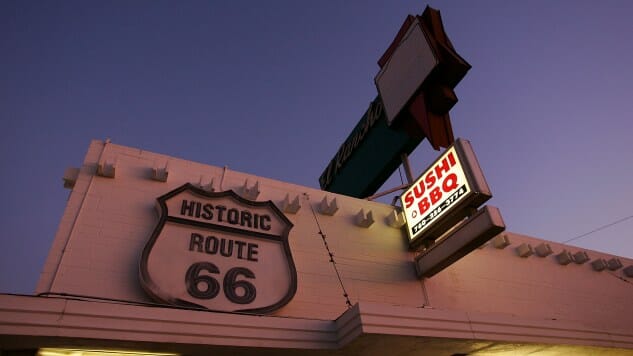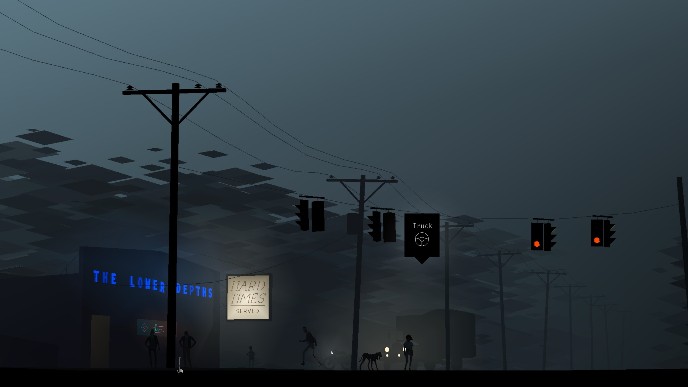
I think it was in Tucumcari, New Mexico, that I first felt the urge to rush to the end of the road. My wife and I, both schoolteachers, had set our entire summer aside to accomplish one of her long-held dreams: Driving the entirety of Route 66, from Chicago to L.A. By the time our trip started, we’d already traveled much that summer, from our home in Atlanta to our parents’ in Ohio and then to Chicago, where the Great American Road Trip begins on the shore of Lake Michigan. When we spent a lazy afternoon in run-down Tucumcari, waiting for the remnants of the Road’s neon-tinted ghost to come alive after nightfall, we were a little less than halfway through our trip of 2500 miles.
“If we get up early,” I said, sitting on the edge of the tiny bed in the Blue Swallow Motel, “we could have lunch in Albuquerque.”
“You don’t wanna see Santa Fe?”
I chewed on that for a moment. I’d never been to Santa Fe. It was just a couple hours out of the way, a day trip at most. The landscape of New Mexico was stunning, a joy to drive through. The weather had been fine.
I stared out the tiny window and couldn’t turn my mind from the Santa Monica Pier. The end of the road.
At some point, every sufficiently lengthy road trip in my mind becomes The Oregon Trail. You start by outfitting your vehicle with provisions: we had coolers full of food, a nice camping set, plenty of extra clothing, and a playlist of classic American rock and doo wop—but no spare tire. You decide how quickly you want to consume your rations: we ate as often as we could from our coolers, reasoning that every peanut butter and jelly lunch allowed us one more stop at one of the greasy spoons that populated the Mother Road. You set your pace: For the first half of the tour, we traveled leisurely—staying off the interstate wherever possible. And the profession you’ve chosen dictates how much money you have with which to barter on your journey: we were teachers, so… not much.
Fortunately, we were never forced to attempt to caulk our Kia Soul and float it across the river, and we never had any bouts with dysentery.
But despite the fact that our trip was, for all intents and purposes, a pleasure cruise, right around the time we hit Tucumcari I started to feel antsy about finishing. The point of The Oregon Trail is to successfully navigate the Trail and arrive in the Willamette Valley. You don’t get any points for lingering several days at Chimney Rock to take in the sights.
Surely the point of traveling Route 66 was to bear witness to the faded glory of twentieth-century America, and not merely to arrive at Santa Monica Pier, spit in the Pacific Ocean, and proclaim “We did it!”
I agreed to take the trip to Santa Fe.
We passed a lovely afternoon exploring the Plaza, the Palace of the Governors, and the Cathedral of St. Francis, but as we grabbed a meal at a hole-in-the-wall burrito place, I felt restless again.
“If we get through Albuquerque this afternoon and keep heading West,” I suggested, “we could camp at Bluewater Lake State Park, near the Arizona border.”
My wife frowned over her green chile sopapilla. “You don’t want to spend time in Albuquerque?”
I was sure that Albuquerque was a fine city. But no. “We stayed in a hotel last night,” I argued, “so we should camp tonight. And Bluewater looks like the only good place to do that.”
This was the Oregon Trail argument manifesting itself again. We have limited resources. If we want to make it to the finish line, we have to scrimp and save where we can afford to.
We sped through Albuquerque, taking in none of its charm (if charm indeed it has, I wasn’t there long enough to verify), and pressed on toward the state park, which took longer to reach than I’d guessed it would. As we rolled down a poorly-kept dirt road, not quite sure if we weren’t headed in the wrong direction, the sun set over the mesas and threatening clouds appeared on the horizon.
Guilt gnawed at me. In my haste, I thought, I’d tried to ford the river, the one thing every grade-school student knows you should never, ever do.
We reached the camping area as the last rays of sunlight were disappearing from the sky, and we hastily assembled our tent in the dark. I spent some time apologizing.
The next day took us through Petrified Forest National Park and onward to Winslow, Arizona, so we felt obliged to take it easy. We stayed in a Motel 6, which on this particular trip, was the height of luxury and comfort. I even agreed to take a whole day to visit Sedona.
The day after that, the Road took us through Seligman, Arizona, and my vision of Route 66 as The Oregon Trail fell apart.
Route 66 was the lifeblood of Seligman, ferrying business and tourism through the little town until it was bypassed by I-40 in 1978. If you’ve seen Pixar’s Cars, you know this story: Seligman is the town on which the run-down auto-hamlet of Radiator Springs is based, a village made destitute by the departure of freeway traffic.
As we munched on burgers at the Snow Cap Diner (“Real Dead Chicken!” they advertise on their menu), I gazed at the lonely Main St. of Seligman and had a revelation: Route 66 wasn’t the Oregon Trail of my classroom days. It was a game I’d played much more recently. It was Kentucky Route Zero.

Kentucky Route Zero is a game about a great many things, but fundamentally it is a story about looking below the surface, stripping away the facade of the ordinary and finding the magical underneath. The protagonist, Conway, in attempting to make a delivery, finds himself in an America that is distinctly off the beaten path. He and his companions traverse a landscape of subterranean highways, giant eagles that roost in museums, office buildings populated by bears, and other, weirder wonders. Where The Oregon Trail is all urgency, Kentucky Route Zero is ponderous, meditative, slow. It is a road trip, in a sense, along the eponymous Route, but the journey is far more important than the destination.
I finished my burger, wiped my hands on one of the Snow Cap’s trademark “slightly used napkins,” and thought about Conway.
“It says there’s a Route 66 Museum in Kingman, just a couple miles out,” my wife said, looking at our map. “You want to stop?”
“Absolutely,” I said, fishing in my pocket for my keys. “We’ve got all afternoon.”
We spent several hours in the Kingman Route 66 Museum, and all the while I kept an eye out for giant eagles.
Nate Ewert-Krocker is a writer and a Montessori teacher who lives in Atlanta. His first book, an adventure novel for teens, is available here. You can find him on Twitter at @NEwertKrocker, where he mostly gushes about final boss themes from JRPGs.
